Navigate
Article List
- 2024 ASIA PACIFIC PRECIOUS METALS CONFERENCE SUMMARY
By Joni Teves, Chief Precious Metals Strategist, UBS Investment Bank
- An Overview of Selected Singapore Legislation Applicable to the Gold Market
By Leong Yi-Ming, Partner, Allen & Gledhill LLP
- Unveiling The Reserve at APPMC 2024
By The Reserve
- The Perth Mint – Celebrating 125 Golden Years
By Sawan Tanna, Treasurer, The Perth Mint
- SINGAPORE’S RISE AS ASIA’S GOLD HUB
By Koh Guan Ho & Lee Liang Le, Analysts, Kallanish Index Services
- Shanghai Platinum Week 2024: China’s PGM Future Takes Flight with Innovation & Collaboration
By Edward Streck, Director of Research, WPIC
- SBMA News
By SBMA
Article List
- 2024 ASIA PACIFIC PRECIOUS METALS CONFERENCE SUMMARY
By Joni Teves, Chief Precious Metals Strategist, UBS Investment Bank
- An Overview of Selected Singapore Legislation Applicable to the Gold Market
By Leong Yi-Ming, Partner, Allen & Gledhill LLP
- Unveiling The Reserve at APPMC 2024
By The Reserve
- The Perth Mint – Celebrating 125 Golden Years
By Sawan Tanna, Treasurer, The Perth Mint
- SINGAPORE’S RISE AS ASIA’S GOLD HUB
By Koh Guan Ho & Lee Liang Le, Analysts, Kallanish Index Services
- Shanghai Platinum Week 2024: China’s PGM Future Takes Flight with Innovation & Collaboration
By Edward Streck, Director of Research, WPIC
- SBMA News
By SBMA
2024 Asia Pacific Precious Metals Conference Summary
By JONI TEVES, Chief Precious Metals Strategist, UBS Investment Bank
Several notable themes emerged during the 2024 SBMA APPMC. First, the physical gold market has really stood out this year, with reports of strong buying despite high premiums. It is worth noting how robust demand has been, especially in the context of the price movements we’ve seen this year. Second, it is important to highlight that in Asia, consumers bought gold even at its peaks because it is an attractive alternative to other onshore assets. It is considered a way to preserve wealth and protect against inflation, currency weakness, and economic uncertainty. It was interesting to see this across the region, not just in the largest physical markets. In many ways, the motivation is the same as that of Western investors, but the expression is different in that in Asia, gold investment is primarily through purchases of physical products. Third, gold seems to be adapting and exerting its relevance to the next generation, which is a credit to the efforts of the industry. This includes adapting jewellery offerings to cater to the tastes of the younger generation, selling through new digital platforms, and generally making it easier to invest through digital and mobile applications. Finally, the concept of evolution was an important theme throughout the conference, and rightly so, given the SBMA’s 30-year journey so far and the many years it has ahead. There have been many changes in the ASEAN precious metals markets over this period, and we can look forward to many more, including the development of cooperation between China and Southeast Asia. Additionally, changes in India and the Middle East corridor and their implications for the region are something to look forward to.
A key thread during the first session was to congratulate and celebrate the SBMA’s 30 years of working towards growing the precious metals industry in the region and looking ahead to the next phase of unifying the APAC bullion market, with Singapore as a hub. This was kicked off with KL Yap’s Welcome Address and Ivan Tan’s speech, which highlighted how far the industry has come in this region and how important this conference has become. Some things that stood out included the partipation of more than 500 attendes from over 20 countries, with numerous networking opportunities across the many corporate events hosted during the week of the conference.
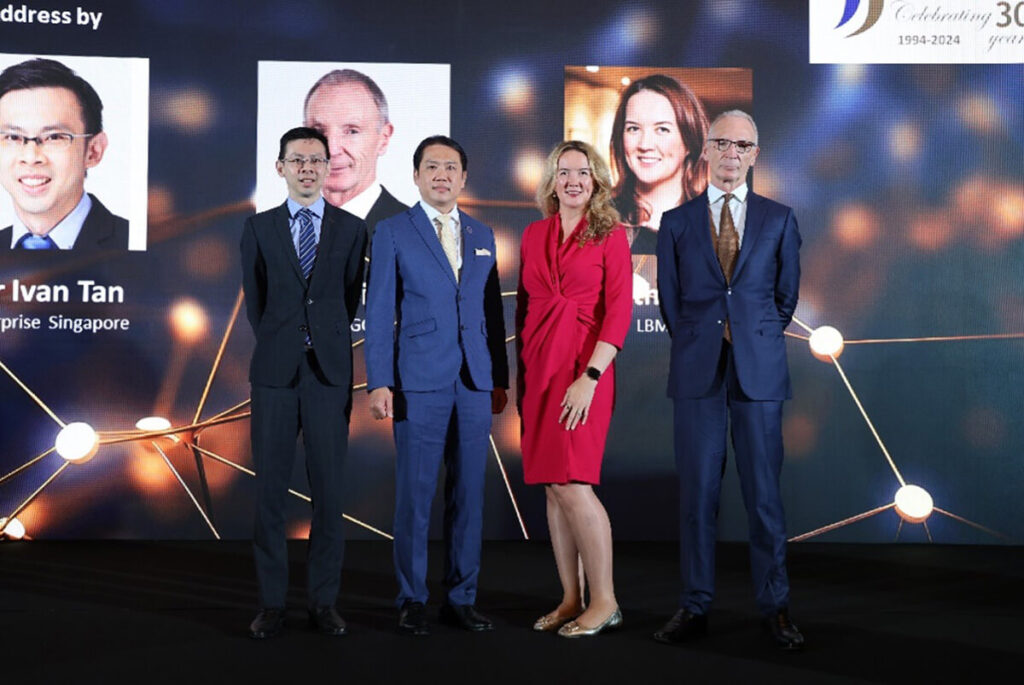
David Tait further highlighted Singapore’s potential as a regional hub and how the WGC supports these initiatives and shares this vision. He highlighted Singapore’s ideal characteristics for this role, such as stability, transparency, and strong regulatory frameworks, among other things. Tait’s discussion on digitalisation of gold and the GBI database tied in nicely with the next speech from LBMA CEO Ruth Crowell, who delved into the Gold Bar Integrity programme and how the LBMA has been working with partners in the region to achieving a state where kilobars are readily acceptable in London. The ultimate goal is to establish a global and transparent digital ecosystem.
The first keynote address by Jin Tik Ngai then provided an economic outlook for the US and ASEAN. He described how the current situation in the US is different, why the economy has held up, and how rate cut expectations have been reduced from three cuts to one. For EM Asia, the resilience of US capex suggests that trade is likely to be supported, with expectations that EM Asia FX will rebound later in the year. However, there is a divergence in the recovery profile in Asia, where those exposed to tech – such as the KRW and TWD – are seen to be outperforming, while others like JPY and THB are not doing as well. Average rates in Asia are lower than those of the Fed, and these negative rate differentials are expected to persist, potentially dampening the upside for Asian currencies. Ngai also pointed out potential headwinds from the higher positive correlation between EM FX and CNY. In China, policy easing has been gradual, with effectiveness proving to be a challenge. The property sector is still a drag, policy certainty is lacking, and confidence is still low. For gold, Ngai said that their outlook is constructive from both a cyclical and structural standpoint. US real rates, the dollar, risk aversion, uncertainty and geopolitical risks are key price drivers. He noted that their fair value model for gold suggests that prices are trading at a large premium due to central bank buying, a structural trend that they expect to continue. They have a year-end target of $2,500 and highlight that they expect gold to rally after the Fed cuts rates.
The second keynote speech was from Shaokai Fan, who drew parallels with the F1 Grand Prix by saying that Singapore is in “pole position”, the most favourable starting position in a race, earned by the driver with the fastest qualifying time. Fan noted that Singapore has the potential to become a vaulting location for central banks in the region, given its proximity, political stability, reputation of trustworthiness and strength in logistics. This, in turn, can help enhance liquidity. All in all, the industry can win by attracting more liquidity, deepening links with regional markets and gaining government support. Fan’s keynote address was followed by the inauguration of SBMA Retail Investment Committee, with Gregor Gregerson as chairman of the Singapore chapter, the first one being rolled out in Asia. Some goals of the committee include preventing or discouraging the use of precious metals in money laundering, helping members authenticate gold and silver products, providing support for members to discuss and address issues, and ultimately improving the retail market in Singapore and beyond.
The inauguration was followed by a special address from Chengdong Zhang on observations of the gold market in Hong Kong and Mainland China. Zhang noted that demand for gold products continues to increase, especially in the retail space. This year, there was strong growth during the Chinese New Year for gold and silver products. The younger generation has shown interest in various forms of gold, including ETFs, derivatives, tokenised products, and jewellery. More generally, consumers are turning to gold for investment. He also noted that gold’s negative correlation with the dollar has broken down and is evolving, given the impact of geopolitics and changes in the structure of the market amid a greater variety of participants.
The following session focused on updates from ASEAN precious metals markets, chaired by SBMA’s Albert Cheng. Huynh Trung Khanh started the discussion with an update on Vietnam’s gold market. According to him, in 2023, demand was at 55 tonnes, mostly for investment. In H1 this year, gold demand already reached 33 tonnes, up 10% year-on-year. He expects a total of 65-70 tonnes of gold demand from Vietnam this year, with over 70% accounted for by investment. Reasons for strong demand include the decrease in savings rates, a stalling property market, and currency devaluation. Amid this strength in demand, gold bars at one point were selling at the equivalent of $3,020/oz. This prompted the central bank to conduct gold bar auctions for the first time in 10 years, providing 50,000 bars so far at the time of the conference. Following the infusion of gold bar liquidity, the premium dropped from $600 to $150. According to Khanh, the industry expects more policy changes ahead, such as the liberalisation of the market and the creation of a national gold exchange patterned after the SGE.
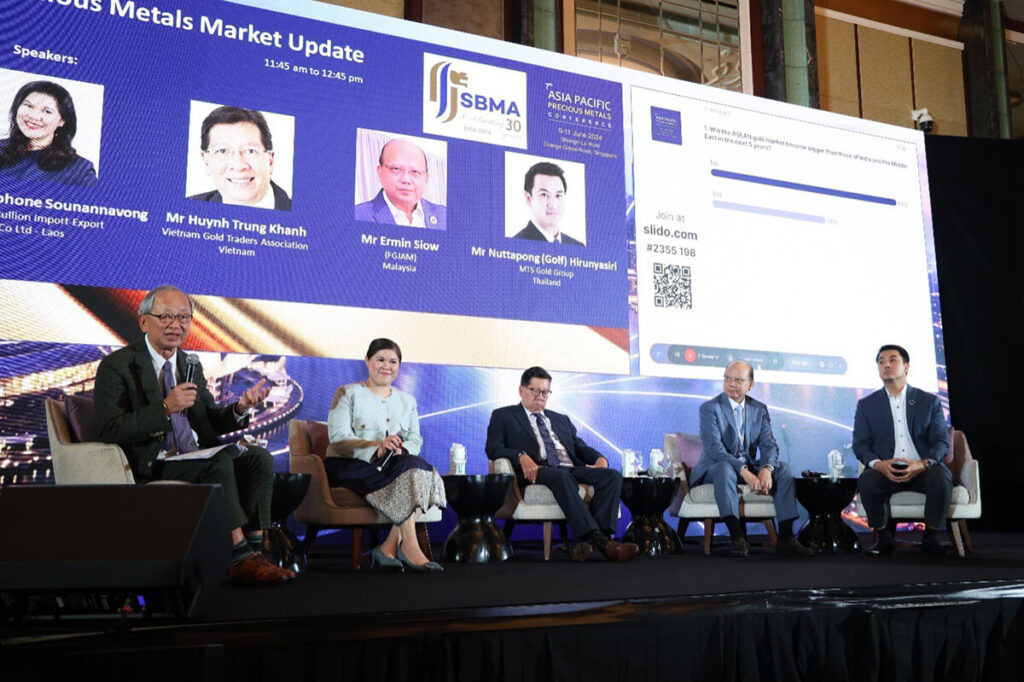
Ermin Siow then provided an update on Malaysia’s gold market. Unlike Vietnam, jewellery demand is higher than investment in Malaysia. Absolute volumes are also smaller, with around 16.6 tonnes of net demand in 2023. Malaysia exports more gold than it consumes, sending most of it to the Middle East and Singapore. Interestingly, a notable trend since the COVID pandemic is the increase in online sales. From 14% in 2023, this has grown to 16% so far this year and is expected to reach 20% in the next two years. There has also been a shift towards gold jewellery from gem sets, accounting for 90% of sales, up from 80% previously. That said, the industry continues to face challenges. The introduction of a high-value-goods tax is expected to be a headwind, though it is not yet clear when this will be implemented. E-invoicing is also being introduced this year for full implementation by 2026; this requires customers to present TIN or valid IDs, and this additional obligation could potentially dampen jewellery demand. On the other hand, opportunities include additional spending power, given the possibility of withdrawals from the Employment Provident Fund, which could be as much as $20 billion to $30 billion and a 13% pay rise for government employees.
In Thailand, Nuttapong (Golf) Hirunyasiri noted this year was the first time he has seen consumers buying instead of selling as gold prices rallied to all-time highs. The sense is that consumers are monitoring global developments for news that could potentially push gold higher and they are forming long queues to buy gold ahead of potential price increases. He also noted that the share of bullion purchases compared to jewellery is increasing. Given that equity markets have reached their lowest levels in six years, gold is an attractive asset for investment and capital gains. The market has also seen the digitalisation of gold trading – it is available on Pao Tang, a government platform with 10 million users, as well as other platforms such as Dime, where securities houses provide liquidity. This has been an avenue for investing in gold amid a lacklustre equities market.
Finally, there was an overview of Laos’ gold market from Souphaphone Sounannavong. We learned about the country’s nascent gold market, which is still in its early stages of development. That said, there is a lot of enthusiasm about its future. The country is the third largest gold producer in the region, with 9-12 tonnes of gold output. They are seeing growing demand for gold given economic and currency uncertainty. For now, the country is mainly exporting its gold production because there is still no domestic refinery or standards in place. Various market participants are still not interconnected and the regulatory landscape is new. The financial sector in Laos is also in its infancy, which means there are limited investment opportunities and therefore gold could be part of the offering. Sounannavong highlighted that there is a lot to learn from peers. The short-term goal is to build a bullion bank. Later on, they plan to establish dore and bar certification. In the long run, the intention is to become part of the conversation and participate more actively in the region, which is expected to help support the market’s development.
China’s Gold Market and ASEAN Collaboration
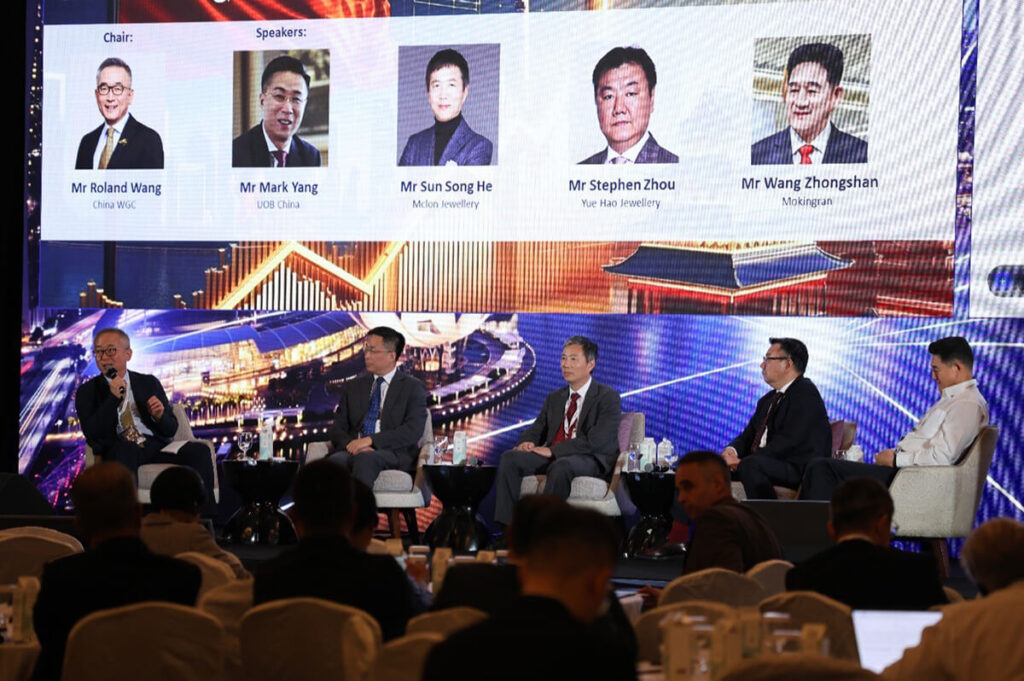
The session chaired by Roland Wang explored how China’s gold market could collaborate with ASEAN countries. While the old Silk Road took trade through the Middle East, the session tackled the potential for the “New Silk Road” to focus on trade with the ASEAN market. The discussion started with Wang Zhongshan, who shared insights into jewellery manufacturing, noting that jewellery produced using machines is three times faster than hand-made jewellery and has a near-zero defect rate. Steven Chow then discussed the ruse of B2B livestreaming for selling jewellery online and the digitalisation of products available both online and offline. Chow emphasised the importance of partnerships, such as collborating with museums to showcase gold products and working with Tencent to reach younger customers. Chow believes these platforms are key to engaging ASEAN consumers. Sun Song He provided a perspective on differentiating his business by targeting a specific market. He underscored the importance of understanding customer preferences and how using technology can support the business, particularly in managing supply chains and using AI for real-time business and inventory management. Later, Mark Yang highlighted the need for support from the financial system, especially in enhancing interconnectivity between China and ASEAN markets. The session was then followed by the signing of the MoU between SBMA and the Shenzhen Gold and Silver Jewellery Creative Industry Association.
Australia’s Role in the APAC Precious Metals Market
Jordan Eliseo discussed Australia’s role in shaping the APAC precious metals market, noting that the country’s regulatory framework provides a supportive environment. Australia’s advantages include high-quality sourcing and favourable logistics due to its time zone and ease of moving material. He highlighted that Asia is no longer just at Australia’s doorstep; it’s in its living room, with 30% of population born overseas, including 1.5 million people from China and India, the latter seeing the fastest growth. Many also come from Nepal, Vietnam and the Philippines.
Eliseo also pointed out that gold ETFs in Australia make up around 2.5% of all ETF assets, compared to 1% globally, and that gold turnover, at around $162 billion, is “very high” compared to Australian stocks and bonds, making them a good alternative for investors to protect their portfolios. He noted that there is potential demand from superannuation funds, which are expected to triple by 2043.
Updates from Japan, Korea, and Australia

The third session, chaired by Kazuya Naoki, focused on updates from Japan, Korea, and Australia. Yuichi (Bruce) Ikemizu discussed how gold in yen has been Japan’s best-performing asset this year, with yen weakness and and a shift from a prolonged period of deflation changing the investment mindset in the country. In Japan, as in the rest of Asia, there has been more buying than selling at record-high gold prices. Interestingly, a younger market for gold has emerged in Japan since the COVID pandemic.
In Korea, Sean Jung noted that the country has been a net exporter in recent years, reflecting an the opportunistic market. Around 75% of demand is for jewellery, with the rest accounted for by industrial usage. Korea also has a large silver surplus, which it exports. He provided a history of the Korean gold market, from the removal and subsequent revamp of GST to the ongoing efforts to resolve issues in the gold and silver markets.
Cameron Alexander then provided an update of the Australian market, focusing on supply and demand. Australia accounts for ~8% of global supply, with expectations of stable supply due to new mines coming onstream and increased exploration. Demand in Australia is evenly split between jewellery and investment, though the recent sharp rally in gold prices has dampened demand and increased scrap supply. He noted that a 10% GST applies to gold purchases unless it is the first purchase. There are opportunities for increased gold demand in Australia, particularly in the jewellery sector, driven by demand from expats.
Key takeaways from this session include: Korea and Japan are generally net exporters of gold, though this trend may be changing in Japan; most gold from these countries are headed for China via Hong Kong or Singapore, with London as a last resort; and taxes can be a challenge, weighing on demand in Korea. Additionally, there is a need to increase brand awareness for Japanese and Korean brands in Southeast Asia, where Swiss-branded bars are currently perceived as premium.
Women in PGMs and the PGM Market
Session 4 kicked off with a fireside chat featuring representatives from women in PGMs, chaired by Zhouying Jing. Zhenzhen Liu discussed the platinum jewellery market and highlighted consumer interest in environmental, social and governmental (ESG) factors, based on a PGI survey. Kate W. Harada focused on diversity and inclusion initiatives, noting that there is room for improvement. The session also included an update on the mentorship program for women in PGMs.

The session then moved to opportunities and challenges for the PGM market, curated by the WPIC. Dominic Wood opened the session with thoughts on creating a future for PGMs. He emphasised the need to scale existing demand segments like hydrogen, jewellery, and investment, while creating new demand segments. Trevor Raymond presented the investment case for platinum, saying that platinum stands to benefit from the proceeds of profit-taking in gold. He highlighted its rarity – 20 times less available than gold – and its strong demand, limited supply and its undervaluation, given platinum is less than half the price of gold despite five years of deficits expected ahead and inventories worth only six months of demand. The panel, which included Tony Chen, James Bian and Simon Huang, noted that platinum is a “young” metal, with the potential to create new customers. They also discussed recycling; it was noted that capacity has expanded considerably and is much larger than available feedstock. Scrappage schemes in China could increase scrap volumes but also spur demand as old autocatalysts are replaced with new ones. Finally, the panel noted Singapore’s advantages as a traditional commodity centre, with a pool of traders and an established market for physical trading and derivatives.
Silver Market Discussion
The second day of the conference started with a discussion on silver by Michael DiRienzo, who pointed out that although silver is often overshadowed by gold, it is a beautiful metal with a long history of use. Valued for its conductivity and anti-microbial properties, silver is used in various industries, including solar energy and electric vehicles. Solar demand for silver is expected to increase by 20% to over 200 million ounces this year, while automotive industry demand for silver is also forecasted to grow as vehicles become more complex. Finally, he pointed out that silver is also considered a store of value, having been used as a currency historically.
Middle East and India: Emerging Hubs for Precious Metals

Session 5, chaired by Amar Singh, provided updates on the Middle East and India. Dubai has become a key supply hub, particularly for India, with the Comprehensive Economic Partnership Agreement (CEPA) serving as the gateway. Government support has been crucial, with a focus on regulations, responsible sourcing, and anti-money laundering policies. Panelists discussed the UAE’s increasing role in the global gold market, driven by regional demand growth its strategic location. India, one of the largest consumers of gold, has seen significant market changes, including the India International Bullion Exchange (IIBX) and increased trading activity and participation from Indian banks.
Singh noted highlighted the growth in India’s gold imports, which have risen to 600-900 tonnes from around 400 tonnes historically. The introduction of the free zone and the exchange has further transformed the market. He also noted that the Middle East has also seen many changes since the introduction of DMCC. Sudheesh Nambiath discussed the Middle East’s market reforms since 2019, noting that the UAE’s exports increased significantly since 2023, with main destinations including China, Switzerland, Turkey and India. Compliance measures have built trust, and government support has been pivotal in making the UAE an attractive environment for foreign investors, he said.
Mohammad Ayyob reiterated the government’s focus on regulations, responsible sourcing, and anti-money laundering, which has created a favourable environment for business in the UAE. Monal Thakkar highlighted Dubai’s growth over the past seven years, supported by government initiatives, and its role in facilitating trade with India and other regions.
Focusing on India, Neville Patel discussed the changing role of Indian banks, which can now participate more actively in the gold market. Banks are allowed to import gold as importers rather than on consignment, participate on IIBX, and engage in in derivatives trading to hedge price risks. He also noted the growing significance of the Dubai-India gold and silver corridor, which is becoming increasingly vibrant. Ashok Gautam provided more context, noting that the IIBX had seen around 13 tonnes of gold and around 1 million kg of silver traded in the year to date. The IIBX offers opportunities for hedging and developing products around deposit receipts.
Technology and Innovations in Gold
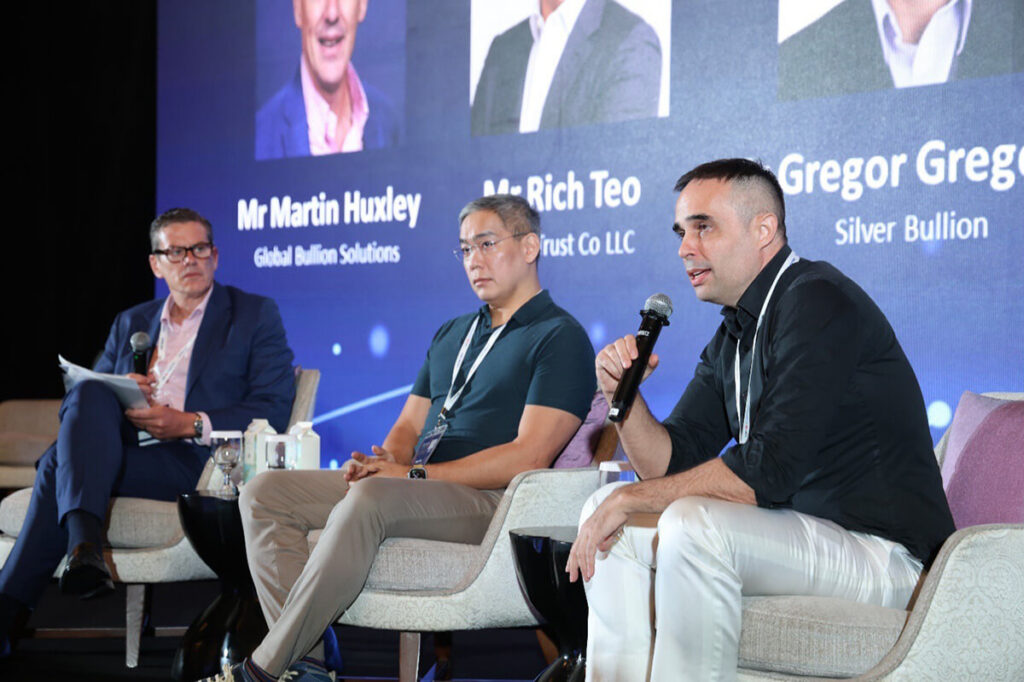
The first fireside chat for Session 6 was on technology and innovations in gold, with the discussion centring on the tokenisation of gold. It was noted that the success of tokenisation projects largely depends on regulation – how the industry embraces regulations and which regulators to approach are key questions to answer. It is interesting that gold is not regulated by one single regulator in the US.
The conversation also covered the movement of tokenised gold globally, emphasising the need for industry standards. Challenges for gold token demand include the cost of holding tokens versus other products, especially the dollar, which earns interest. It is also difficult to to monetise gold tokens, panelists noted. Additionally, participants in the crypto space may not fully appreciate gold’s value. Key factors for future growth include harmonising accepted gold bar standards across different markets to enhance fungibility, and developing systems for traceability. From the consumer side, there needs to be a willingness to see tokenised allocated gold as equal to allocated gold, and a willingness to use tokenised gold as collateral. The panellists note the potential for easier adoption in Asia.
Sustainability and ESG in the Gold Market
The next fireside chat was focused on gold’s sustainability impacts and goals. Peter Bouwer shared their experience in developing an ESG strategy into the core of their business step by step. Dedo Liang discussed the importance of leadership in the gold industry, noting the efforts of miners to decarbonise, which positively impacts the entire value chain. The session highlighted that while significant progress has been made in decarbonization, there is still a long way to go.

Precious Metals Price Outlook and The Gold Report
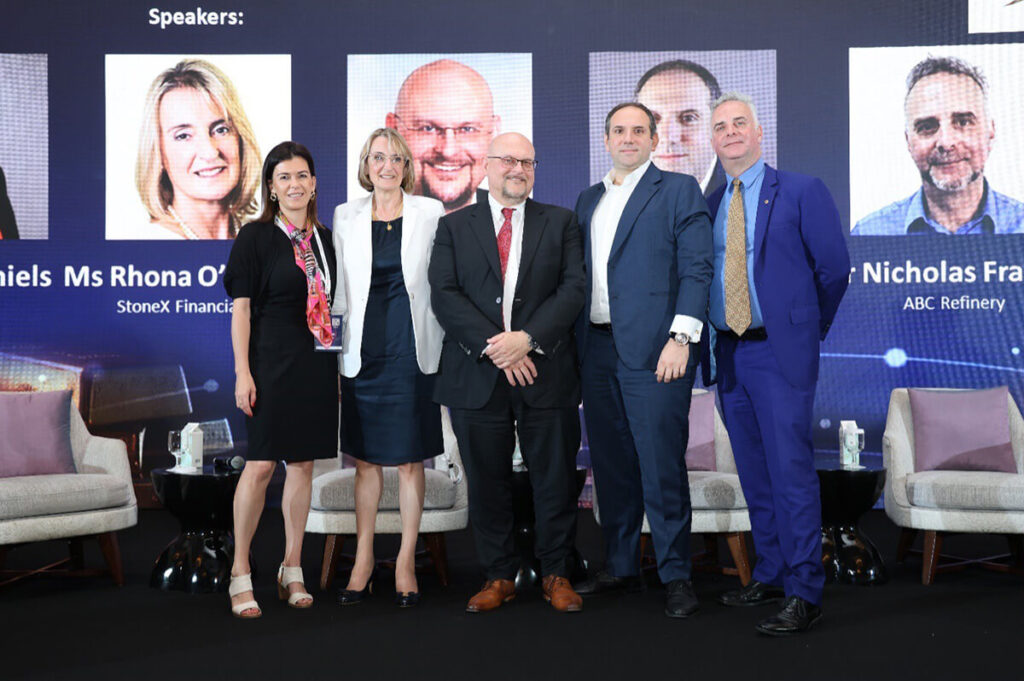
The conference concluded with the Precious Metals Price Outlook Round Table moderated by Nicky Shiels and launch of The Gold Report by Metals Focus. Nikos Kavalis provided a review of the gold price trend, noting that while the market has reached a nominal all-time high, it had not done so in real terms. He talked about the resilience of both supply and demand, strong official sector purchases and the expectation that these conditions are likely to continue this year. The panelists expect gold to do well with an average of $2,250, up 15% year-on-year, with prices making new highs before the end of the year. Bart Melek talked about his expectation for the Federal Reserve to cut rates three times this year, starting in September. With the cost of carry becoming significantly lower, this should attract institutional investors to turn to gold via ETFs and Comex longs. Melek also noted that he expects the USD to grind lower rather than collapse, for purchasing power to be eroded over the next decade or so, and for rates to be low give large US deficits. Rhona O’Connell; talked about central bank buying expectations and how volumes as well as the signal that purchases send to the market are both important. Nicholas Frappell then mentioned that producer hedging is still out of fashion and that there is little secondary supply little secondary supply coming from Asian markets. The lack of scrap supply likely came from expectations of a continued rally in gold prices and wanting to hold gold to protect against local currency weakness.
The panel went on to discuss that for retail investors to get back into gold, particularly in ETFs, there might need to be a correction in the equities market and opportunity costs of holding gold coming down. With regards to elections spurring interest in gold, the panel discussed how general elections were a key risk in the US, with the Republicans in the White House there’s likely to be less retail gold investment compared to a scenario with a Democrat in office. The panel noted that a hung Congress is likely to represent the most uncertain outcome, and could be the most bullish scenario for gold. A Trump presidency, according to the panel discussion, could mean tax cuts, continuing debt and deficit problems as well as other geopolitical uncertainties. A Republican president and Congress could mean higher deficits and lower real rates, which would be good for gold. When asked whether something in the system could break, similar to the GFC in 2007/2008, the panel noted that 1) there are risks in the small to medium size banking sector, 2) an adversarial US stance might increase official sector gold buying and 3) assumptions of government support and risks of sovereign insolvency in the long run raises risks for fiat currencies.
Looking beyond gold, the panel had a bullish view on silver given very strong demand, though there is plenty of stock currently. The expectation is that the silver market will see deficits ahead amid industrial demand, particularly from electronics, solar, and new energy applications. Deficits are expected even with aggressive thrifting assumptions. Silver can be very volatile, however, and a buy and hold versus a trading strategy might work better. The panel flagged looking for signs of silver market tightness via forwards.

JONI TEVES is the Precious Metals Strategist within the Economics and Strategy Research team and is based in Singapore. She covers all four precious metals and is responsible for fundamental analysis, forecasting, and writing research pieces on these markets. She has been in the industry for nearly two decades, initially as a gold trader for the central bank of the Philippines, subsequently joining UBS as a strategist in 2011. UBS Precious Metals Research has been frequently voted #1 by clients in the Risk Magazine Survey since 2012. Joni holds a BS Business Economics degree from the University of the Philippines.























